We pray for all those who work and live from the sea, among them sailors, fishermen and their families.
Blessed Stanley Rother
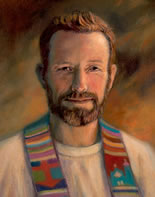 Today is the Feast of Blessed Stanley Rother, martyr.
Today is the Feast of Blessed Stanley Rother, martyr.
As Pope Francis said on the occasion of his beatification in 2017, ““[Yesterday], in Oklahoma City, the missionary priest, Stanley Francis Rother, killed in hatred of the faith for his work of evangelization, and work to promote the human dignity of the poorest people in Guatemala, was proclaimed Blessed. May his heroic example help us to be courageous witnesses to the Gospel, committed to working [on] behalf of the dignity of man.”
St Mary Magdalen
 The emphasis in the spiritual life is on our searching for God. It is difficult not to admit this from the abundance of scriptural sources and the the witness of the saints. We know the accent of seeking when St Benedict makes this the key vocation matter in his Holy Rule. Sometimes I wonder, however, if it is more of realization that we do not find Him, but He has found us. Do we believe that God seeks us? Perhaps it is the experience of both of God seeking us, and we Him. I am thinking of the poem of Francis Thompson, “The Hound of Heaven.”
The emphasis in the spiritual life is on our searching for God. It is difficult not to admit this from the abundance of scriptural sources and the the witness of the saints. We know the accent of seeking when St Benedict makes this the key vocation matter in his Holy Rule. Sometimes I wonder, however, if it is more of realization that we do not find Him, but He has found us. Do we believe that God seeks us? Perhaps it is the experience of both of God seeking us, and we Him. I am thinking of the poem of Francis Thompson, “The Hound of Heaven.”
Nevertheless, St. Gregory the Great describes in terms applicable to anyone seriously engaged in the search for God: “At first she sought but did not find, but when she persevered it happened that she found what she was looking for. When our desires are not satisfied they grow stronger… Holy desires likewise grow with anticipation… Anyone who succeeds in attaining the truth has burned with such a love.”
Back to St. Benedict. His first idea for his school is that prayer should be central to those who seek God. Like the saints teach us, you can’t find the Lord without spending time with Him, listening to Him, learning from him and praising Him. Mother Church gives various methods of prayer: in her liturgies like the Sacrifice of the Mass (Divine Liturgy) and the Divine Office, in Eucharistic Adoration, lectio divina, the Holy Rosary, silence, quiet works of charity, and just simply opening your heart and mind to God, giving Him praise and asking for His help and intercession. Then there is obedience to all of the above and to our spiritual director, the way of humility and the experience of community.
We don’t find God alone, but with and through others; so with St. Mary Magdalen, may we search and find God. May the Magadeln pray for us.
Father Kino’s heroic virtue recognized
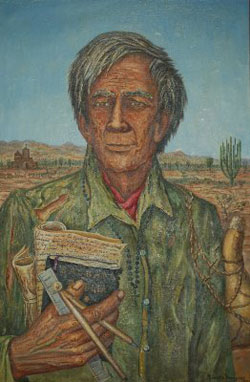
On July 10, 2020, the Pope acknowledged the heroic virtue of the Servant of God Eusebio Francesco Chini (Kino), a priest of the Society of Jesus. Thus, the sainthood cause moves ahead.
Kino, as we know him, was born on 10 August 1645 in Segno, Italy and died in Magdalena, Mexico on 15 March 1711. He was a trained mathematician wanted to imitate the great Saint Francis Xavier. The Jesuit Provincial sent Father Kino to serve as a missionary in what was known as New Spain now Arizona, southern California and Mexico. Kino was called the Horseback priest because his travels covered more than 50,000 square miles on horseback.
At the time of Father Kino’s work the Spaniards forced the native peoples, in particular the Sonoran Indians, to be slaves in the mines. Father Kino was known to oppose the slavery and compulsory hard labor. In today’s atmosphere Kino would be roundly rejected the religious left and secularists. However, Kino contributed to the welfare of others through Catholic Faith, missionary work, education, economy, farming, map making, and constructing.
As a priest he taught others about the truth of Jesus Christ, the need for the Church and her sacraments, and personally baptizing 4,500 people.
His agricultural work draws my attention because it taps into to the care of the person and society. Agriculture also links other things together: faith, reason, science, nutrition, and common sense. Some standards have changed since Kino’s work 400 years ago, but we can see the lines of care and concern for the health of people he interacted with as a missionary. Kino introduced seeds, fruits, herbs, grains, and animal husbandry (beef, sheep, and goats).
Kino now carries the title of Venerable Servant of God. We await a miracle attributed to his intercession. I am looking forward to his beatification someday soon. Father Kino had a generous spirit and a generative character; it is clear to me that his humanity was expansive because of his love of Christ.
St Benedict
Today is the summer feast of the Holy Patriarch Benedict.
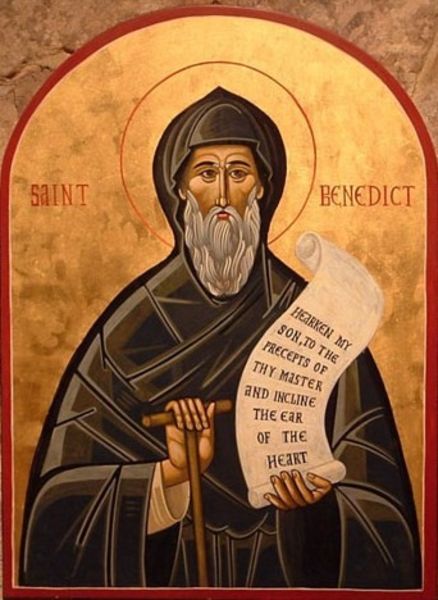
It is a day to heed the advice of Benedict: seek the Lord and listen to him. It is also a day to celebrate the feast with beer made by monks.
Benedict’s vision for monastic life is that the monk/nun live in community. One’s life in a stable, permanent community locates and lives the reality of the Lord’s Incarnation. We are keenly reminded that in Benedict’s experience human interaction shows an experience of Christ: the abbot holds the place of Christ; Christ in the guest, in the young monks, and in the seniors. Ultimately, no one is excluded in the Benedictine vision monastic life: every human interaction the monk/nun meets the Lord, in the flesh. This is keenly true for the Oblate and every other person.
I am remembering the words of Saint John Paul II had for the sons and daughters of Benedict: “May every Benedictine community present itself with a well-defined identity, like a “city on a hill,” distinct from the surrounding world, but open and welcoming to the poor, to pilgrims and to all who are searching for a life of greater fidelity to the Gospel!”
As with all solemn feasts in the Tradition of the Church there is an octave. It is a way to continue to enjoy and relish and to attend to the graces of the feast! Over the next 8 days how will you celebrate St Benedict? What grace will you beg from the Holy Spirit? How will you live the charism bequeathed to us by Benedict and his children through the ages?
Happy 4th
Blessed US Independence Day –July 4th
The Prophet Amos had something to say about politics worth listening to today: “many of the religious leaders were corrupted and tied to political leaders more than to the Lord.” Are you tied to the Lord and His promises, or to political leaders and their vainglory? The Psalms also offer us great perspective.
https://www.youtube.com/watch?v=cAZ8QJgFHOg&fbclid=IwAR1sB1bAGt4T2Q1y3o-_cf-9rgQshdD1N1zLkmcDM9ohTUlQ-7ARMvbn7-I
The Warrior Nun
“It’s like Buffy the Vampire Slayer got religion.”
Well, if you like comedy and religion, you likely will like the new Netflix series, Warrior Nun. The trailer is fun.
As a monk friend said,
The character “Ava is done very well and Beatrice too, and while I am not too keen on the nun aspect (the idea itself verges on the ludicrous), I think they do a good job of it; and the person who plays the priest in charge of them does a very good job also. The more one sees the better it gets I think. Like Buffy it shows the personal difficulty, isolation even, of dealing with supernatural evil that most people don’t believe in much less see. (All people want to be normal, and this kind of life is not normal. As Buffy once said, we want to be “destiny free.”) In the end, Buffy failed because the creator was not up to the vision, and if one really doesn’t believe in this sort of thing–at least in a general sense–it will fall flat no matter how funny, smart and witty one is since you cannot keep it up. Of course, these shows can never show the positive side of the supernatural (which I admit is harder to show visually), of which these darker elements are merely parasitic however scary and powerful they may be.”
What did the pope really say?
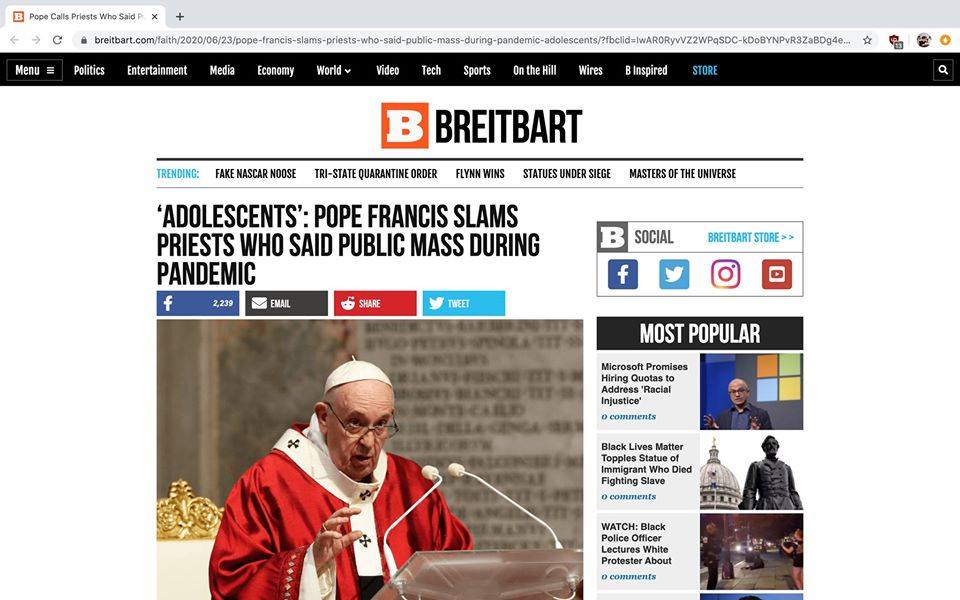 DID THE POPE REFER TO FAITHFUL PRIESTS AS ADOLESCENTS?
DID THE POPE REFER TO FAITHFUL PRIESTS AS ADOLESCENTS?
Kudos to Mark Castor for looking past the inflammatory and irresponsible Breitbart headline to the Pope’s actual words.
ORIGINAL TRANSCRIPT OF THE POPE’S WORDS FROM THE VATICAN WEBSITE:
“In recent months, people have not been able to participate in the liturgical celebrations, but have not stopped feeling like a community. They prayed individually or in the family, also through the means of social communication, spiritually united and perceiving that the embrace of the Lord went beyond the limits of space. The pastoral zeal and the creative concern of the priests have helped people to continue on the path of faith and not to remain alone in the face of pain and fear. This priestly creativity that has won some, few, “adolescent” expressions against the measures of authority, which has an obligation to protect the health of the people. Most of them were obedient and creative. I admired the apostolic spirit of many priests, who went by phone, knocking on doors, ringing houses: “I need something? I do the shopping … “. A thousand things. Proximity, creativity, without shame. These priests who remained beside their people in caring and daily sharing: they were a sign of the consoling presence of God. They were fathers, not teenagers. Unfortunately, not a few of them have died, as well as doctors and paramedical staff. And also among you there are some priests who have been sick and thank God they are healed. In you I thank all the Italian clergy, who have shown courage and love to the people.”
(Pope Francis, Address To Doctors, Nurses and Healthcare Professionals From Lombardy, 20 June 2020)
Mary unites heaven and earth
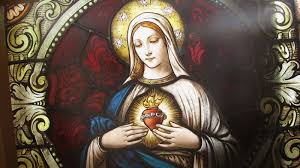 Today, following yesterday’s Feast of the Sacred Heart of Jesus, is the feast of the Immaculate Heart of Mary. The following passage is from St. Maximilian Kolbe:
Today, following yesterday’s Feast of the Sacred Heart of Jesus, is the feast of the Immaculate Heart of Mary. The following passage is from St. Maximilian Kolbe:
In the union of the Holy Spirit with her, not only does love bind these two beings, but the first of them (the Holy Spirit) is all the love of the Most Holy Trinity, while the second (the Blessed Virgin Mary) is all the love of creation, and thus in that union heaven is joined to earth, the whole heaven with the whole earth, the whole of Uncreated Love with the whole of created love: this is the vertex of love.
St Jude, relative of the Lord
 The holy apostle Jude, relative of the Lord is honored by the Byzantine Church today. In addition to being an apostle he is in-charge of difficult cases. He is frequently invoked by medical professionals and those who are living with illness.
The holy apostle Jude, relative of the Lord is honored by the Byzantine Church today. In addition to being an apostle he is in-charge of difficult cases. He is frequently invoked by medical professionals and those who are living with illness.
“Like many of the other apostles, Jude’s name has several variations. In the Gospels he is called Judas; Luke adds, “son of James,” and John says parenthetically, “not the Iscariot.” Matthew and Mark call him Thaddeus, no doubt because of the odium associated with the name Judas. Jude, as we know him, was one of the Twelve, and a relative of Christ through James.
Aside from mention of Jude in the Gospels and his own letter which is part of the New Testament Canon, there is nothing known of his life or manner of death.
The Epistle of Jude is addressed to all Christians. His work was a contribution to the complex struggle of the infant Church against heresy. Jude’s letter is witness to the Church’s steadfast confirmation of Apostolic Tradition and law.” (NS)